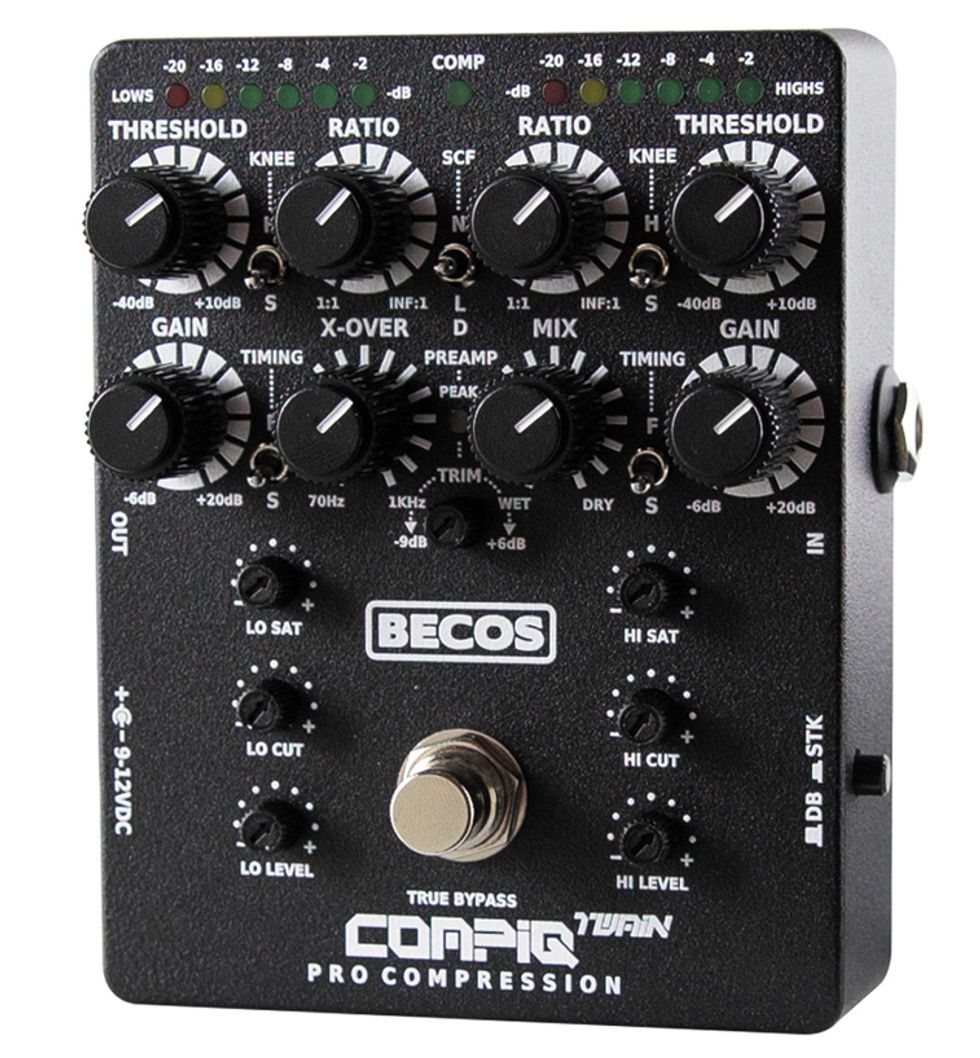Recorded direct using an Mbox and running Logic X.
Clip 1: Fender Ultra Jazz 4 (60/40 favoring neck pickup) Band 1: Threshold 10 o’clock, ratio 11 o’clock, gain 11 o’clock, x-over 11 o’clock/Band 2: Threshold 2 o’clock, ratio noon, mix 11 o’clock, gain 11 o’clock.
Clip 2: 1985 Yamaha BB3000S, with tone at 50 percent and neck pickup onlyFender Ultra Jazz 4 (60/40 favoring neck pickup) Band 1: Threshold 10 o’clock, ratio 1 o’clock, gain 10 o’clock, x-over 8 o’clock/Band 2: Threshold 5 o’clock, ratio 11 noon, mix 8 o’clock, gain 10 o’clock.
Clip 3: 1985 Yamaha BB3000S, with both pickups dimed. Band 1: Threshold 10 o’clock, ratio 10 o’clock, gain 10 o’clock, x-over 2 o’clock/Band 2: Threshold 11 o’clock, ratio 11, mix 11 o’clock, gain 10 o’clock.
RatingsPros:Incredibly versatile. Classic compression sounds. Dual-band or stacked capability. Cons: Crowded control surface. Plastic controls too close to the footswitch. Street: $342 Becos CompIQ Twain becosfx.com | Tones: Ease of Use: Build/Design: Value: |
The folks at Romania-based Becos are no strangers to building solid compressors, and have a string of well-received, small-footprint units. These units are mostly aimed at users who desire set-it-and-forget-it, studio-quality analog compression. The larger-footprint CompIQ TWAIN model, however, is obviously built for players who have more of an “I want to control every aspect of compression” mentality. And the TWAIN has a sea of compression options available.
Two-for-One
The TWAIN is dual-band, with separate sides for lows and highs. The controls, for the most part, mirror each other. This layout helps in navigating the very feature-heavy panel. The most important switch on the CompIQ TWAIN, however, is located on the side near the input jack. It’s the switch that converts the unit to a stacked compressor. This feature will stack both compression engines in series to achieve a slower, warmer, optical-compression feel. Other important features on top of the pedal include the crossover frequency selector between the two bands, a wet/dry control, and a 3-way side-chain-filter switch. The switches between fast/slow timing and hard/soft knee are also available on both sides of the pedal.
I started out by plugging in a Fender Ultra Jazz 4-string because I wanted to see if I could get a modern, active Jazz bass to sound a little less modern and controlled, both in the highs of the pops and the violent low-end attacks of an aggressively slapped 4th string. And I began using the CompIQ TWAIN in dual-band mode with a 3:1 compression ratio. I switched things up with fast timing on the low side and slow timing for the highs. I was instantly struck by how musical my intentionally heavy squash on the low register sounded. The popped notes lost just a little bit of their inherent harshness and fit better into the line I was playing, a bit like slapping through a tube preamp.
To me, the true test of a great compressor is to determine how it can “glue” a track together with a bass line that features long note values. I grabbed an early ’80s Yamaha BB3000S, engaged the stacked mode, set a soft knee, and utilized the wet side of the signal heavily. I was rewarded with a truly old-school fat—but not muddy—tone, where my low notes were warm, and my high notes gained a tremendous amount of body and authority.
Steak with a Side of Saturation
Since the stacked mode put such a smile on my face, I kept it engaged while rolling all controls on my Yamaha to their wide-open positions and playing meat-and-potatoes rock with a pick, and boosting the saturation controls on the TWAIN up to 3 o’clock. The pedal added a pleasant mid-scoop while providing an audible saturation with the bass soloed, but a saturation subtle enough to where it will just add presence to the bass in a track without having a forward, audible break-up like a fuzz—a very usable feature indeed.
The Verdict
In spite of the larger footprint (4.72" x 4.13"), the CompIQ TWAIN is still a relatively small pedal considering it has the controls of two compressors in one unit. The engineering feat is admirable, but a few of the switches are a little hard to reach if you have “bass player fingers.” The number of features available make this Becos compressor hard to beat for users who demand a wide variety of compression options for different styles and multiple basses. Many compression pedals lose their allure when you can actually hear the compression working. The Becos shines in the heavier settings—compressing like some of the legendary rack units.













![Rig Rundown: Russian Circles’ Mike Sullivan [2025]](https://www.premierguitar.com/media-library/youtube.jpg?id=62303631&width=1245&height=700&quality=70&coordinates=0%2C0%2C0%2C0)





